
Gas prices are a politically sensitive barometer of the economy for Americans. In a petroleum-dependent, mobile society, the price of gas prominently displayed at gas stations in every town is often a topic of angsty conversation for Americans. But as a matter of fact, the U.S. actually has the lowest gas prices of any developed country in the world. Read on to find out why, and see how our international friends and rivals are faring.
Gas prices are determined by supply and demand, but can also be influenced by government policies. The price Americans pay for gas is below average in the world, both because the U.S. is the world’s top oil producer and because government policies help keep prices down for political reasons. Check out: 2 Dividend Legends To Hold Forever and Discover “The Next NVIDIA”
Key Points
What Influences the Price of Gas?
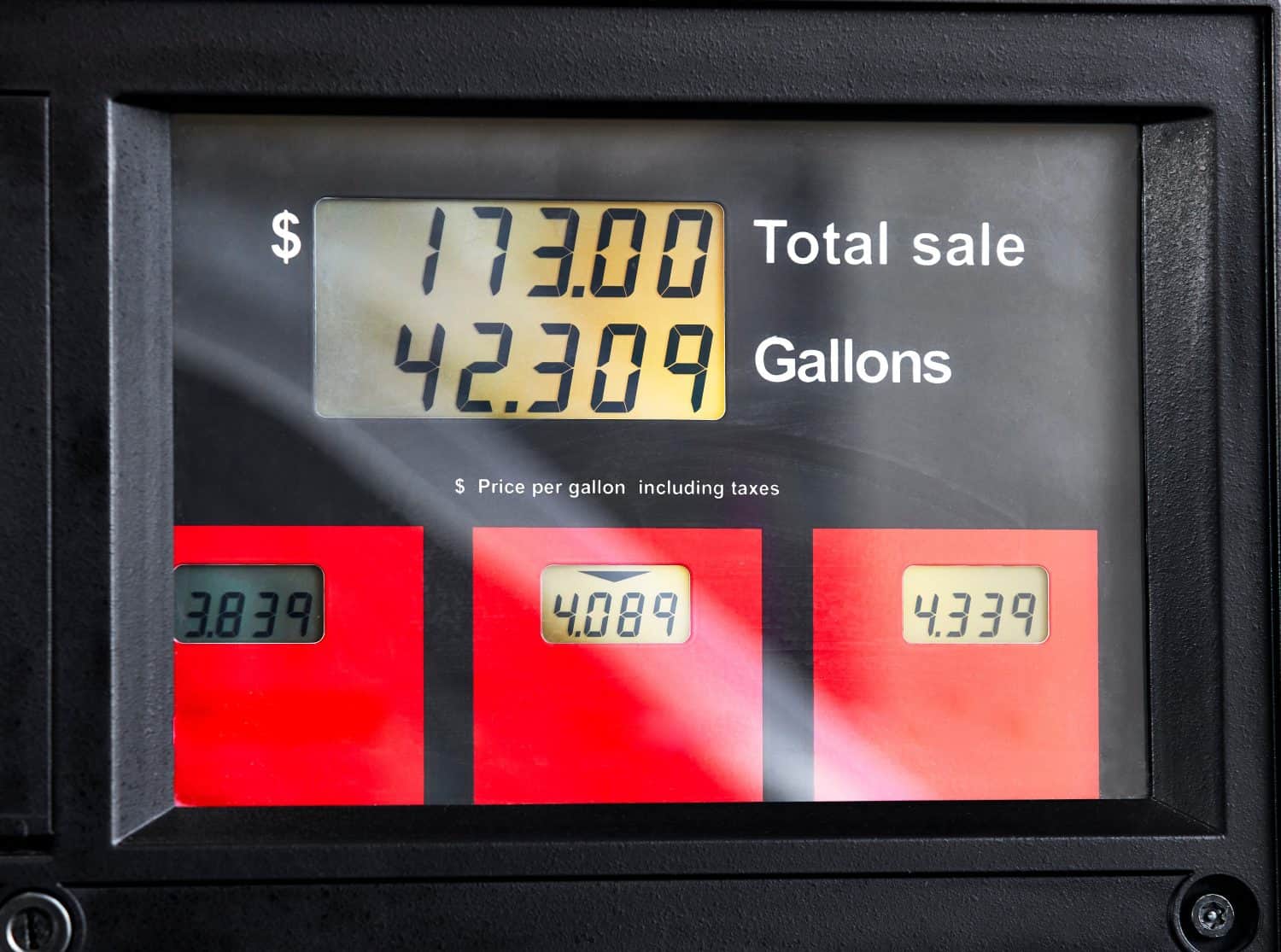
Like everything else in the economy, the price of gas is influenced by supply and demand. Things like winter demand for heating oil and peak travel seasons increase demand, raising prices. Discovery of new sources of oil, new technologies like fracking, or decisions by oil-producing countries to increase production all can increase supply and push prices lower.
National and world events can push prices up. A change in energy policy, an explosion at a refinery, a war or international sanctions in an oil-producing country all create upward pressure on prices. This is true even if we do not buy oil directly from the affected country. In a market economy, when the global supply is restricted, prices go up for everyone.
How Does the U.S. Manipulate Gas Prices?
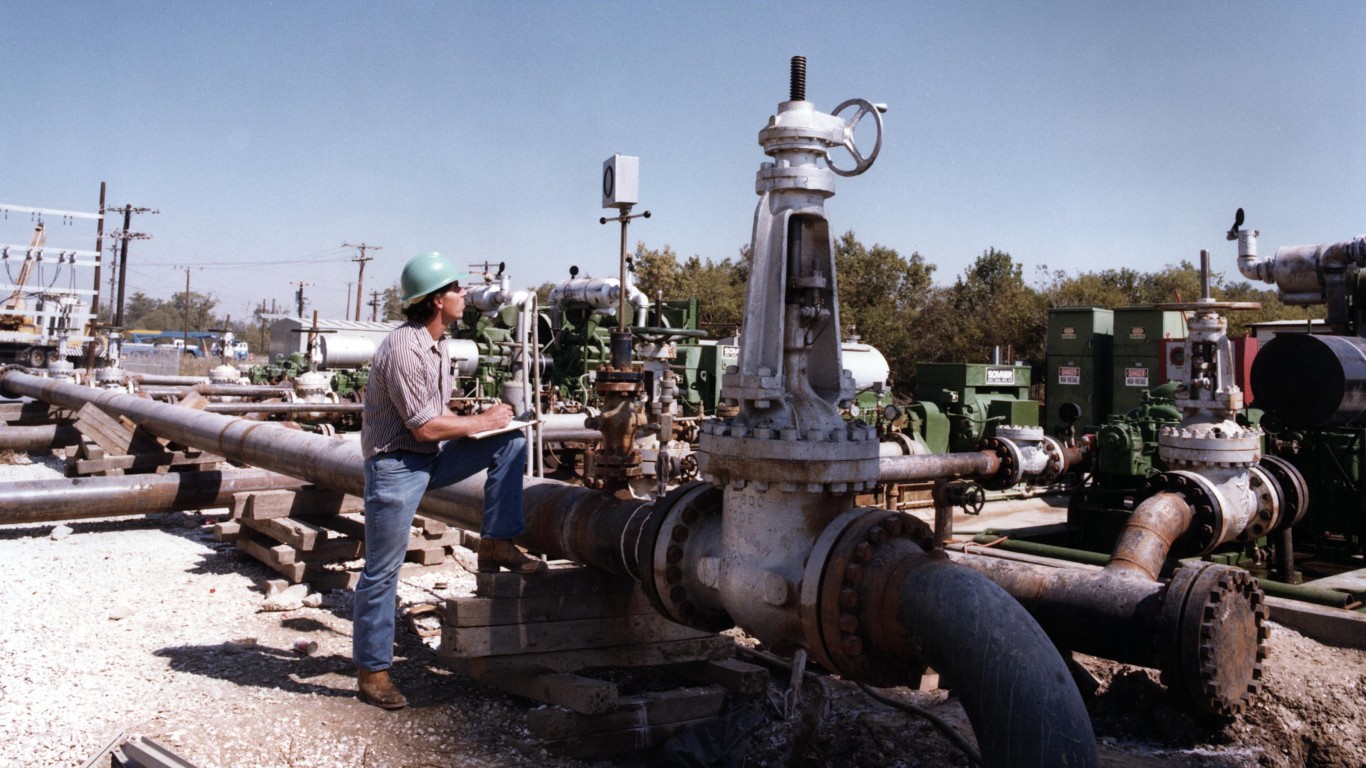
The U.S. government can influence the price of gas by doing things to increase supply, such as opening federal lands to drilling, issuing more drilling permits in general, and approving new technologies like fracking, The president can also authorize the sale of crude oil from the Strategic Petroleum Reserve, a supply of hundreds of millions of barrels of oil the U.S. holds back for emergencies.
To decrease demand, the government can set higher fuel efficiency standards and promote alternative energy-powered cars such as electric or biofuel. Federal and state governments can raise or lower gas taxes to adjust the price. The federal gas tax is currently 18.4 cents a gallon, which is used mainly to fund highways and other transportation-related services. State gas taxes are one of the factors that causes prices to differ state-by-state.
How Do Foreign Governments Manipulate Gas Prices?
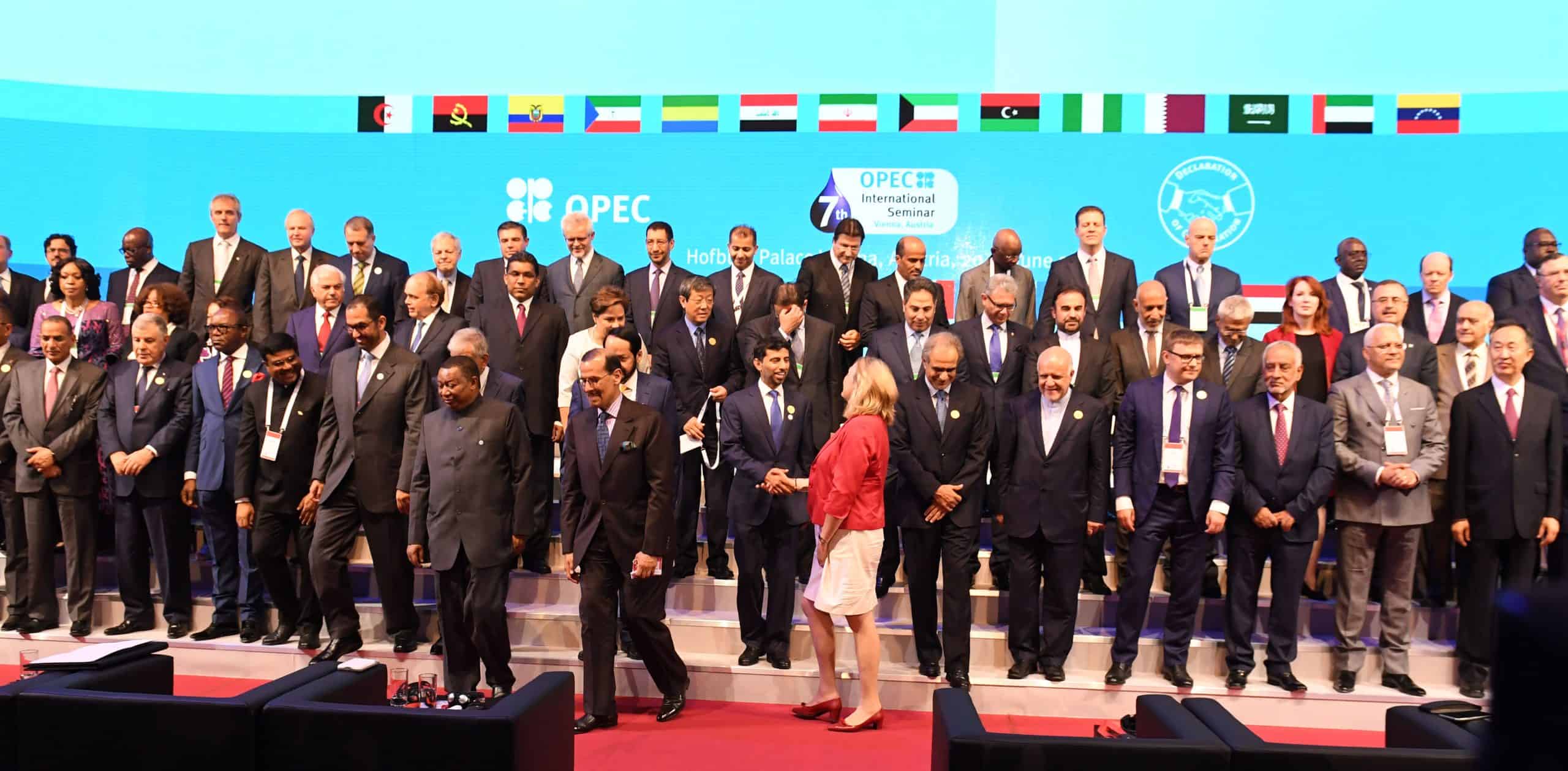
Foreign countries use the same approaches as the United States to influence gas prices, but in some cases have additional tools at their disposal. In some countries the government owns the oil industry and can set prices directly. Governments also may subsidize the price of gas so that consumers pay less. Some countries, such as those in the Organization of Petroleum Exporting Countries, negotiate quotas on member countries’ oil production to regulate supply and keep the price in an agreed-upon range.
Current US and Average Global Gas Prices
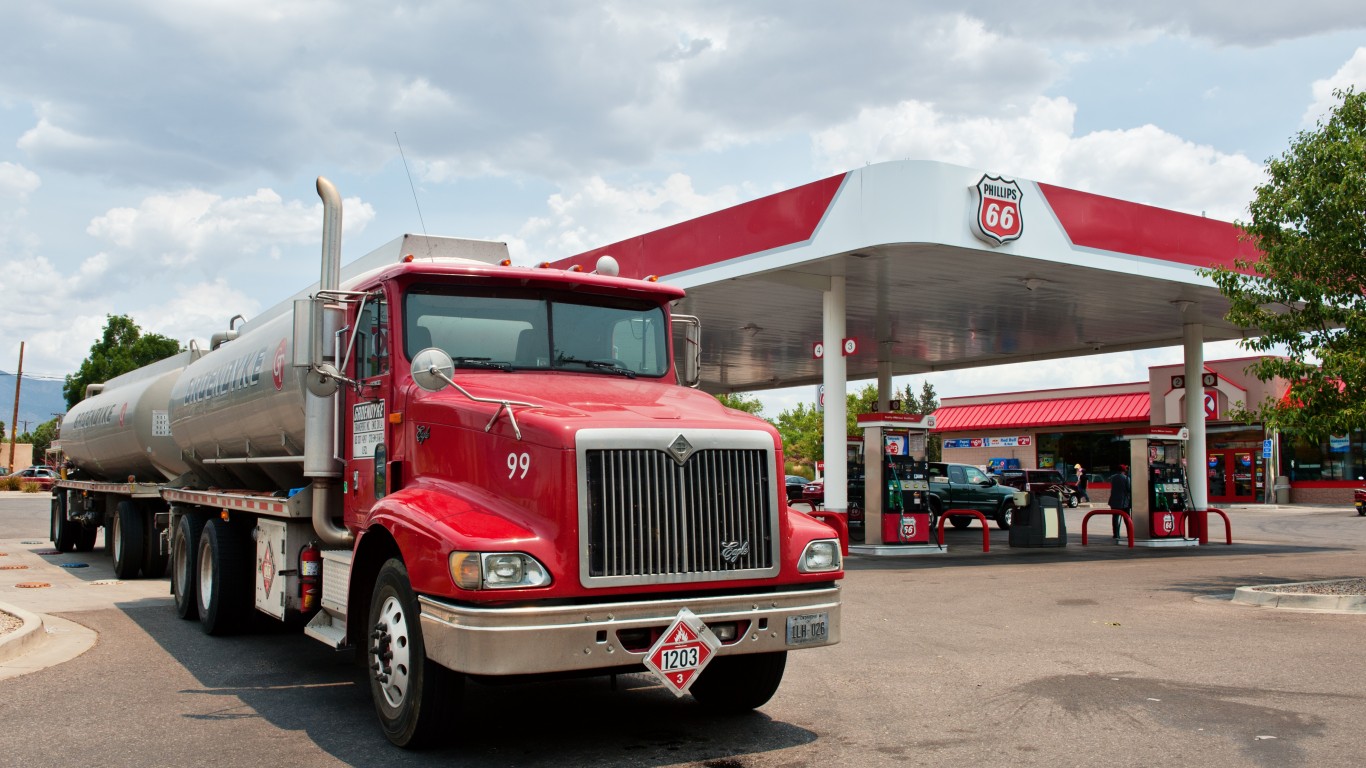
According to GlobalPetrolPrices.com, as of January 6, 2025, the average price for a gallon of 95-octane gas in the U.S. was $3.396. This is a decrease of 3.2% over the past three months, and it is at the same level as last year at this time.
The global average gas price per gallon is $4.67, which is 27.28% more than Americans pay. In effect, American drivers are getting a “discount” of $1.274 for every gallon they pump, compared to the typical international driver.
Countries Where Gas is Under $1 a Gallon
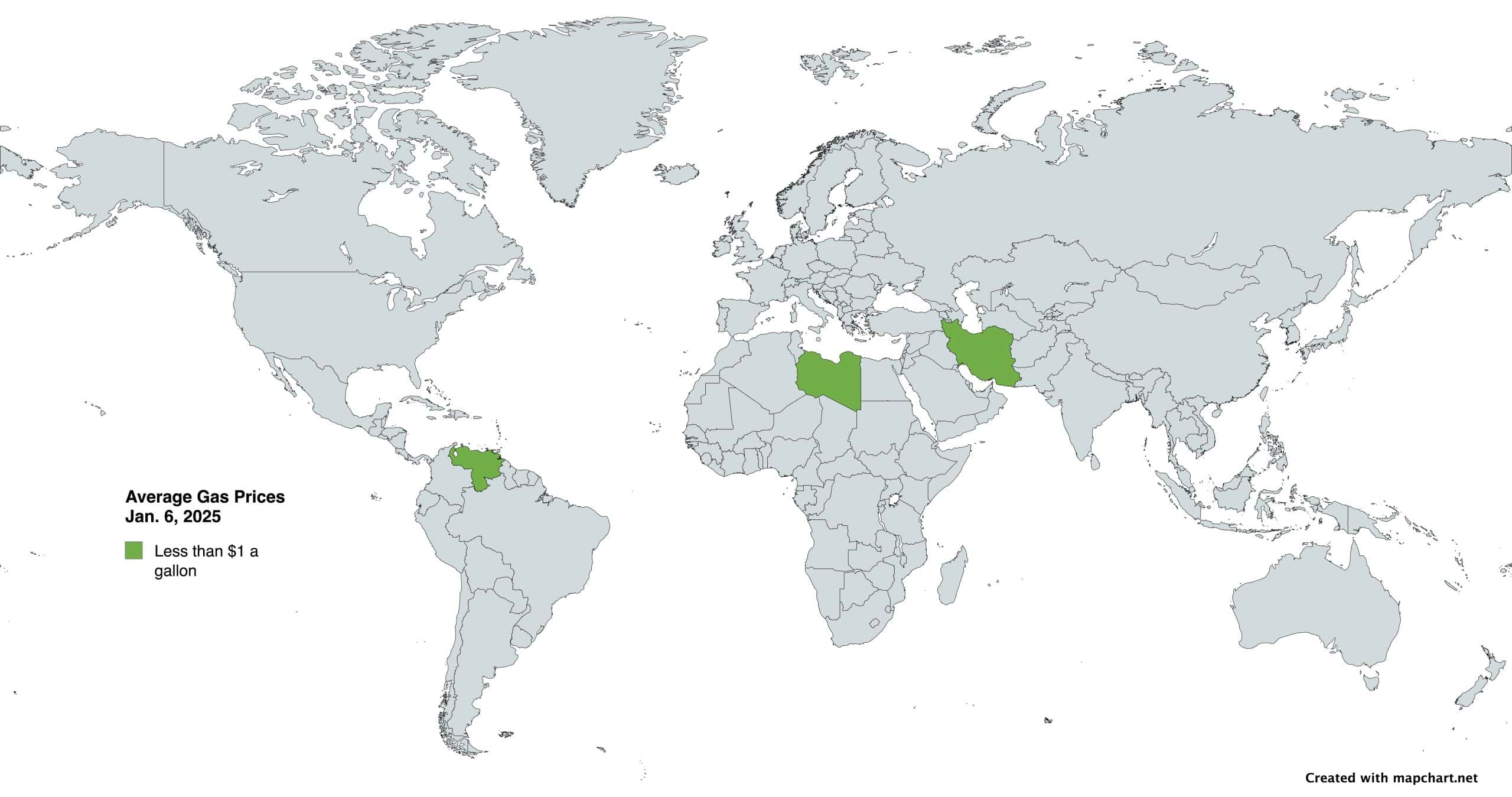
Iran, Libya, and Venezuela are all oil-producing nations with major problems and restive populations. They keep the price of gas artificially low as a way to pacify their people.
- Iran: $0.10
- Libya: $0.115
- Venezuela: $0.132
Countries Where Gas is $1.01-$2 a Gallon
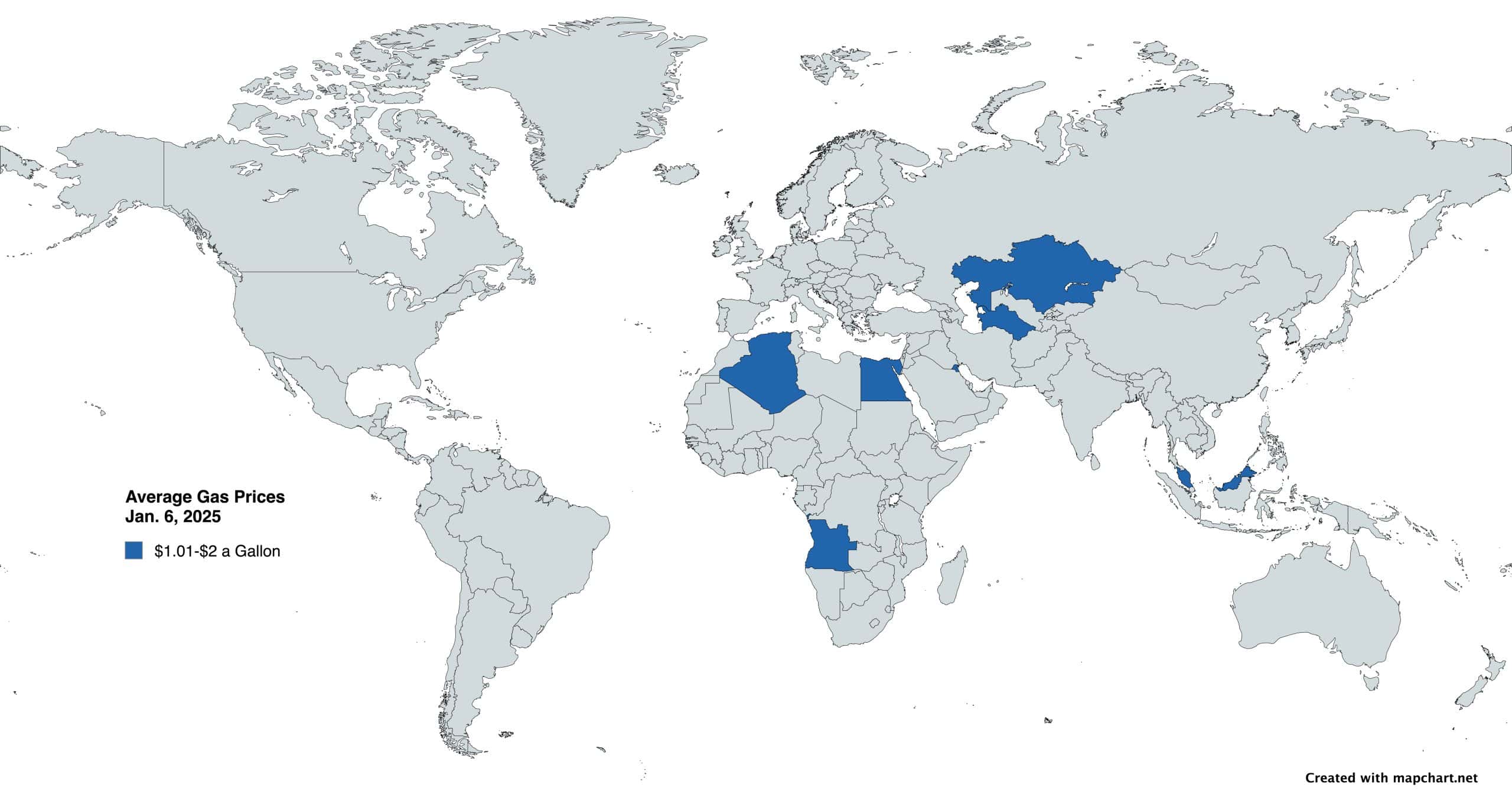
All of these countries are oil producers, so they are able to give their citizens cheap gas to help them be happier with their government.
- Angola: $1.242
- Egypt: $1.271
- Algeria: $1.285
- Kuwait: $1.289
- Turkmenistan: $1.618
- Malaysia: $1.729
- Kazakhstan: $1.751
Countries Where Gas is $2.01-$3 a Gallon
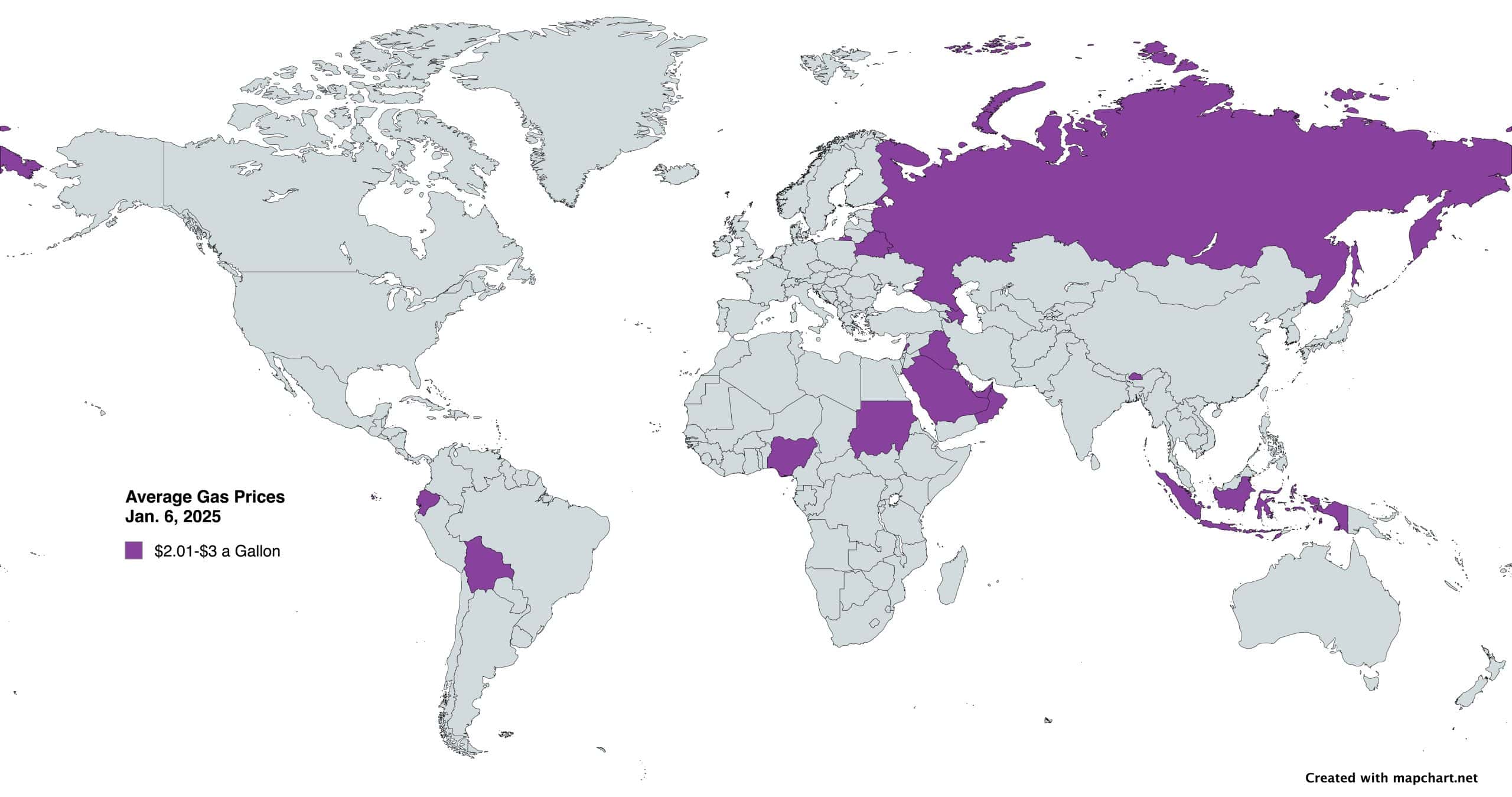
Only a few countries on this list are not major oil producers. One example is Belarus, which has very limited domestic energy resources but receives low-priced oil and gas from Russia. This is one of the tools Russia uses to control Belarus.
- Bahrain: $2.009
- Bolivia: $2.048
- Russia: $2.138
- Qatar: $2.183
- Saudi Arabia: $2.349
- Oman: $2.350
- Azerbaijan: $2.449
- Iraq: $2.456
- United Arab Emirates: $2.577
- Ecuador: $2.642
- Sudan: $2.650
- Bhutan: $2.674
- Lebanon: $2.732
- Belarus: $2.821
- Nigeria: $2.910
- Indonesia: $2.993
Countries Where Gas is $3.01-$4 a Gallon
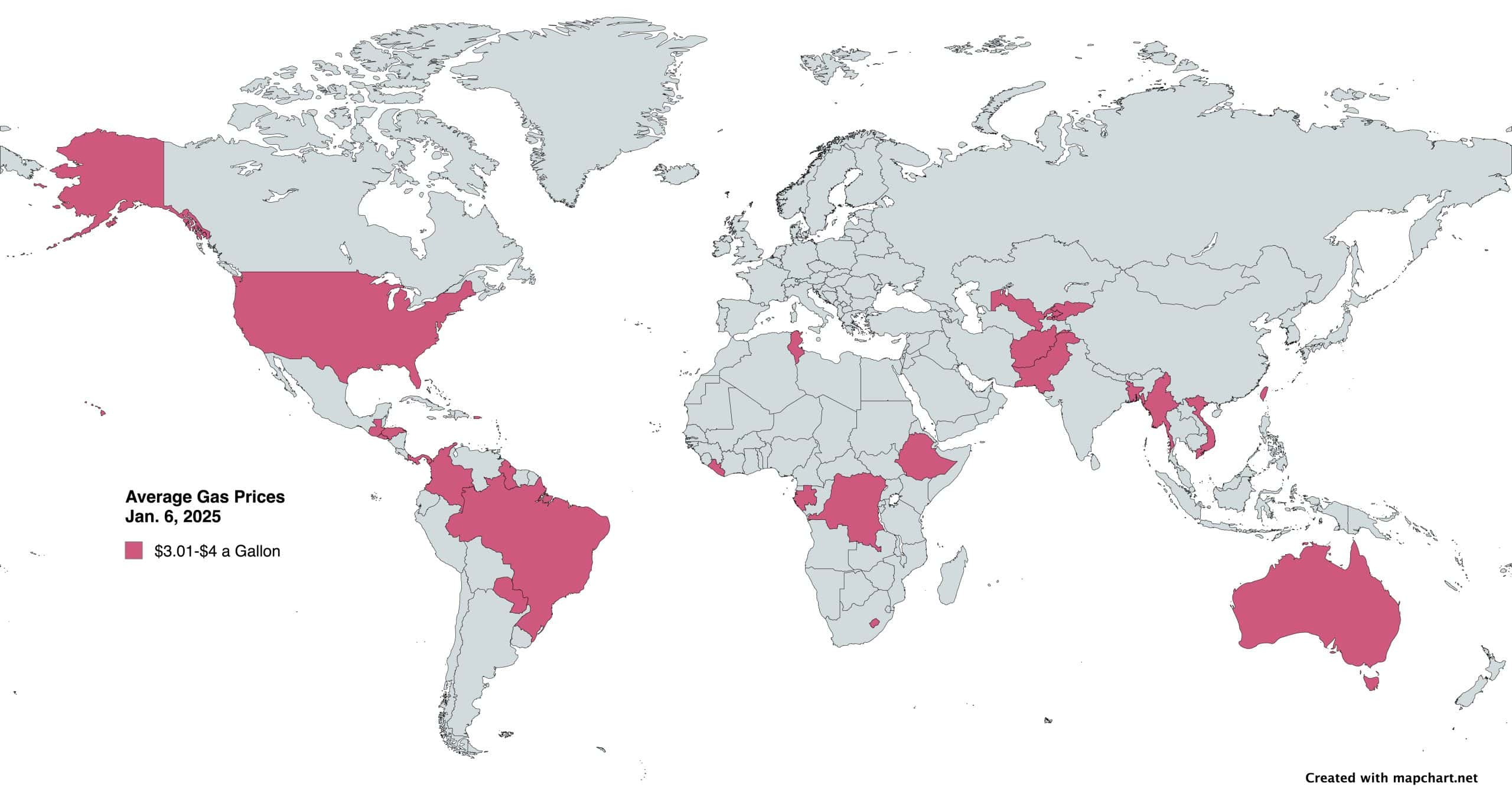
Other than the United States and Australia, all the countries with gas prices in this range are developing nations where higher prices would be a substantial burden on a largely impoverished population.
- Tunisia: $3.006
- Ethiopia: $3.047
- Liberia: $3.139
- Vietnam: $3.163
- Paraguay: $3.172
- Kyrgyzstan: $3.176
- Afghanistan: $3.252
- Panama: $3.360
- United States: $3.396
- Maldives: $3.426
- Pakistan: $3.435
- Brazil: $3,462
- Taiwan: $3.488
- Gabon: $3.574
- Colombia: $3.580
- Myanmar: $3.737
- El Salvador: $3.747
- Uzbekistan: $3.774
- Lesotho: $3.836
- Honduras: $3.870
- Bangladesh: $3.885
- Guyana: $3.888
- Australia: $3.892
- Democratic Republic of the Congo: $3.945
- Guatemala: $3.957
Countries Where Gas is $4.01-$5 a Gallon
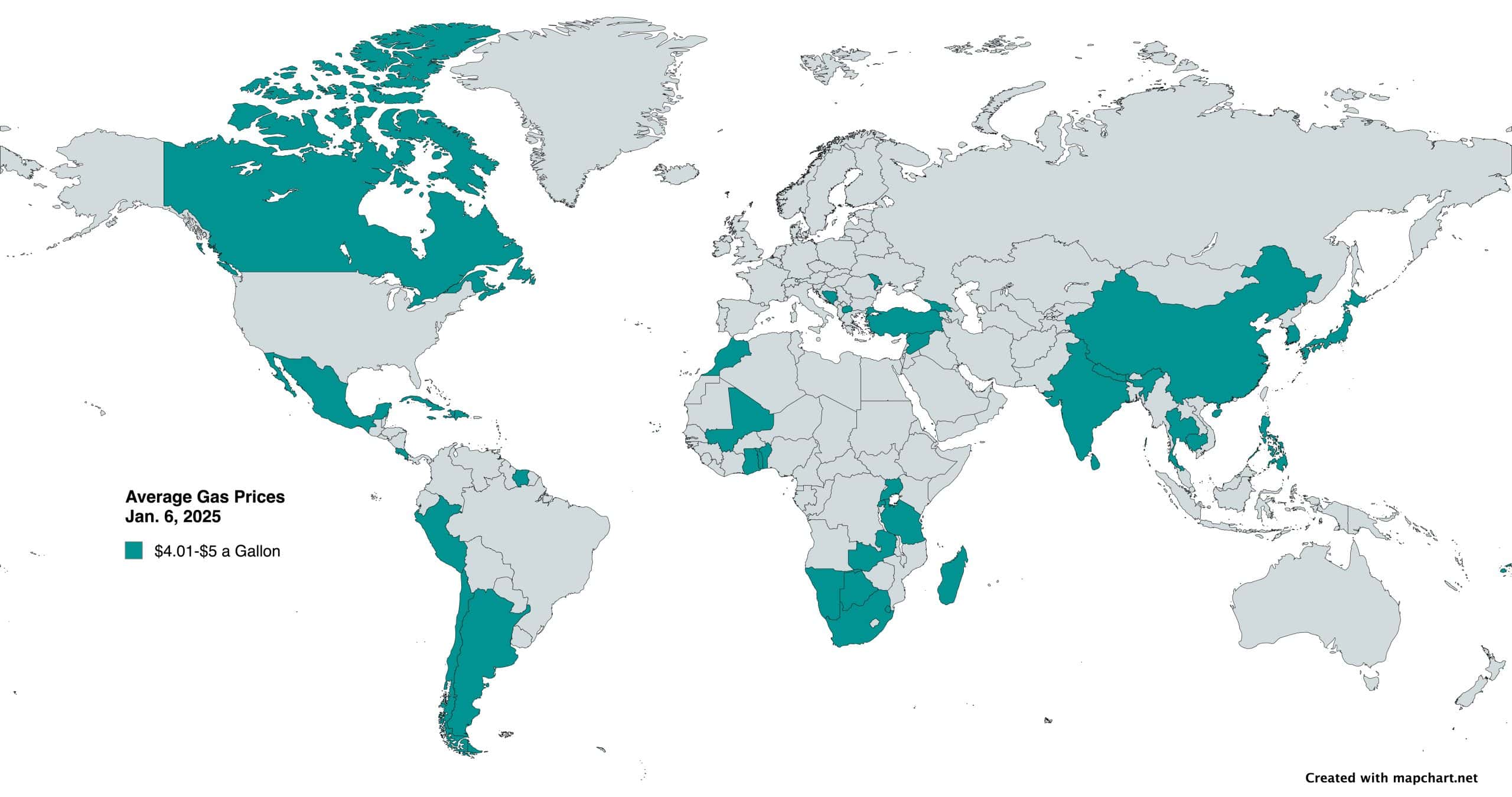
Countries with gas in this price range include highly developed countries like Canada, South Korea, and Japan, as well as middle-income developing countries. These countries have more drivers who are able to afford to pay more for gas. In some cases, prices are higher because of transportation costs to reach more remote areas.
- Ghana: $4.014
- Botswana: $4.027
- Togo: $4.086
- Namibia: $4.099
- Philippines: $4.145
- Georgia: $4.156
- China: $4.163
- Eswatini: $4.170
- Benin: $4.176
- Peru: $4.197
- Mali: $4.206
- Cambodia: $4.263
- Tanzania: $4.265
- South Africa: $4.276
- Haiti: $4.289
- Rwanda: $4.299
- Trinidad & Tobago: $4.323
- Japan: $4.324
- Fiji: $4.352
- Argentina: $4.421
- India: $4.457
- Suriname: $4.496
- Nepal: $4.498
- Grenada: $4.552
- Cabo Verde: $4.630
- Jamaica: $4.643
- Canada: $4.655
- Zambia: $4.673
- Syria: $4.705
- Mexico: $4.726
- Chile: $4.741
- Sri Lanka: $4.751
- Dominican Republic: $4.757
- Madagascar: $4.757
- Moldova: $4.776
- South Korea: $4.807
- Turkey: $4.853
- Bosnia & Herzegovina: $4.855
- Cuba: $4.901
- North Macedonia: $4.904
- Uganda: $4.918
- Morocco: $4.929
- Costa Rica: $4.982
- Thailand: $4.985
- Mauritius: $4.990
Countries Where Gas is $5.01-$6 a Gallon
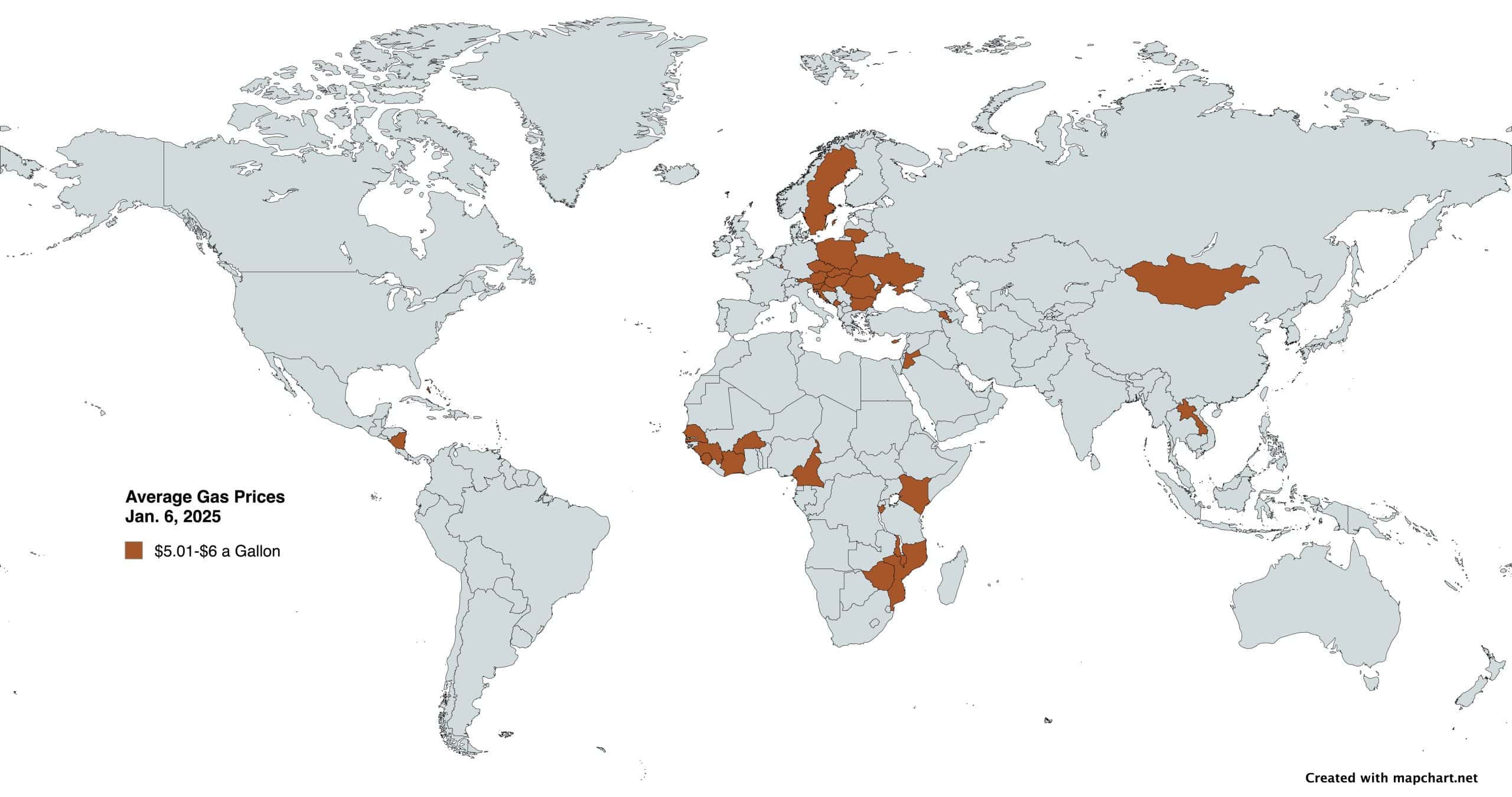
Many of the countries at this price point are in Eastern Europe, which has traditionally been dependent on Russia for oil and gas. The war in Ukraine, international sanctions on Russia, and disruption of the oil pipeline from Russia that runs through Ukraine have all contributed to higher gas prices in these European countries.
- Bulgaria: $5.010
- Dominica: $5.028
- Nicaragua: $5.036
- Armenia: $5.043
- Cameroon: $5.046
- Saint Lucia: $5.084
- Burkina Faso: $5.107
- Mozambique: $5.110
- Kenya: $5.114
- Laos: $5.172
- Ukraine: $5.178
- Burundi: $5.221
- Malta: $5.245
- Sierra Leone: $5.251
- Ivory Coast: $5.258
- Guinea: $5.271
- Andorra: $5.347
- Seychelles: $5.349
- Bahamas: $5.350
- Cyprus: $5.457
- Lithuania: $5.472
- Malawi: $5.523
- Czech Republic: $5.549
- Zimbabwe: $5.602
- Poland: $5.603
- Mongolia: $5.624
- Montenegro: $5.637
- Romania: $5.743
- Sweden: $5.768
- Hungary: $5.774
- Slovenia: $5.825
- Jordan: $5.870
- Austria: $5.938
- Croatia: $5.942
- Senegal: $5.948
- Slovakia: $5.965
Countries Where Gas is $6.01-$7 a Gallon
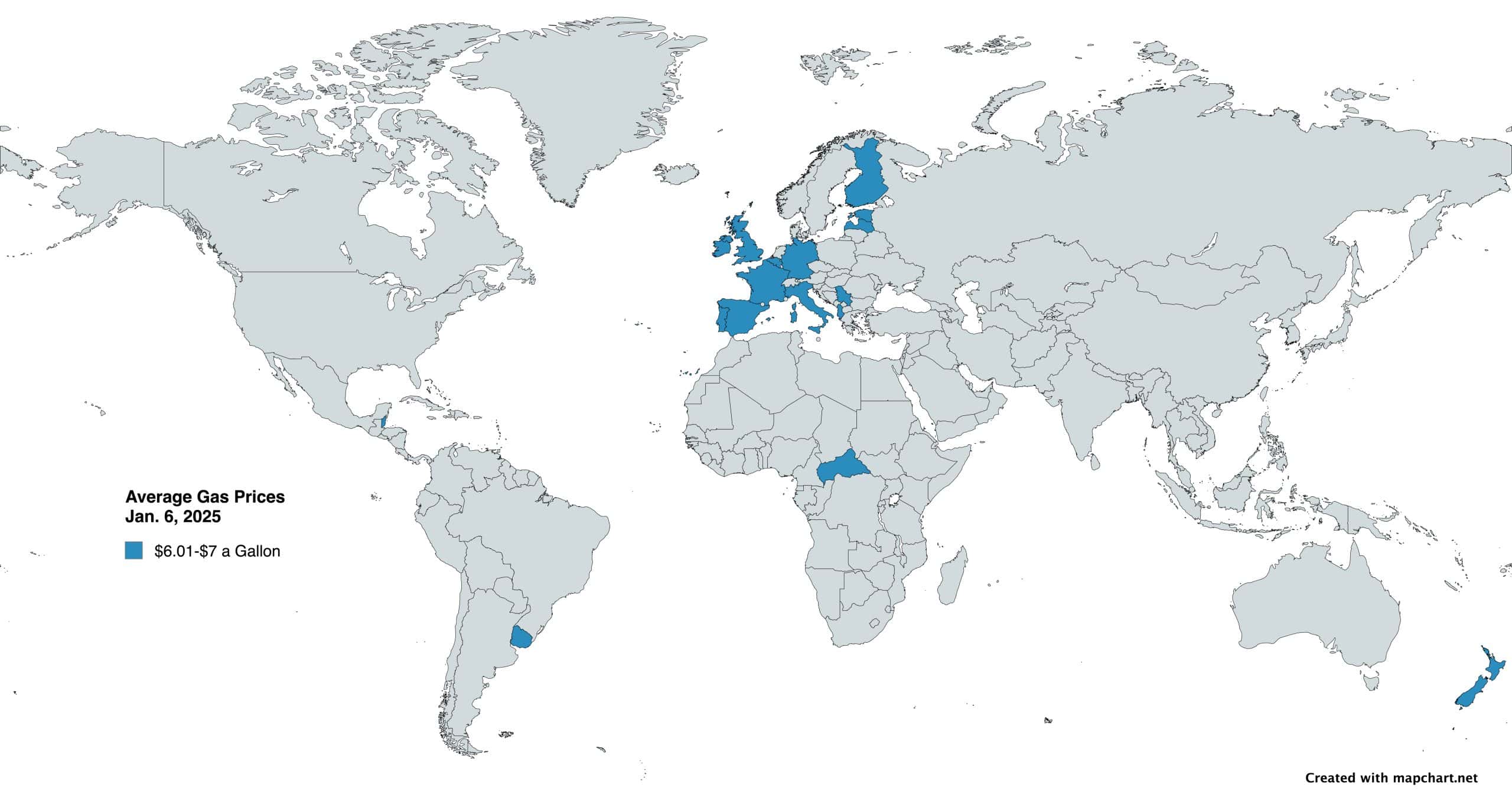
Western Europe imposes a heavy tax burden on its citizens but also provides comprehensive social services to enhance their quality of life. The citizens of these countries also tend to be intensely concerned about climate change and supportive of policies that cut down on driving. Finally, the war in Ukraine and subsequent sanctions have reduced the supply to this region, pushing prices up.
- Luxembourg: $6.005
- Spain: $6.016
- New Zealand: $6.059
- Serbia: $6.086
- Latvia: $6.177
- Belgium: $6.200
- Estonia: $6.369
- San Marino: $6.431
- United Kingdom: $6.452
- Central African Republic: $6.608
- Belize: $6.627
- Finland: $6.721
- Germany: $6.740
- Uruguay: $6.757
- France: $6.820
- Portugal: $6.834
- Ireland: $6.858
- Albania: $6.957
- Italy: $6.997
Countries Where Gas is $7.01-$9 a Gallon
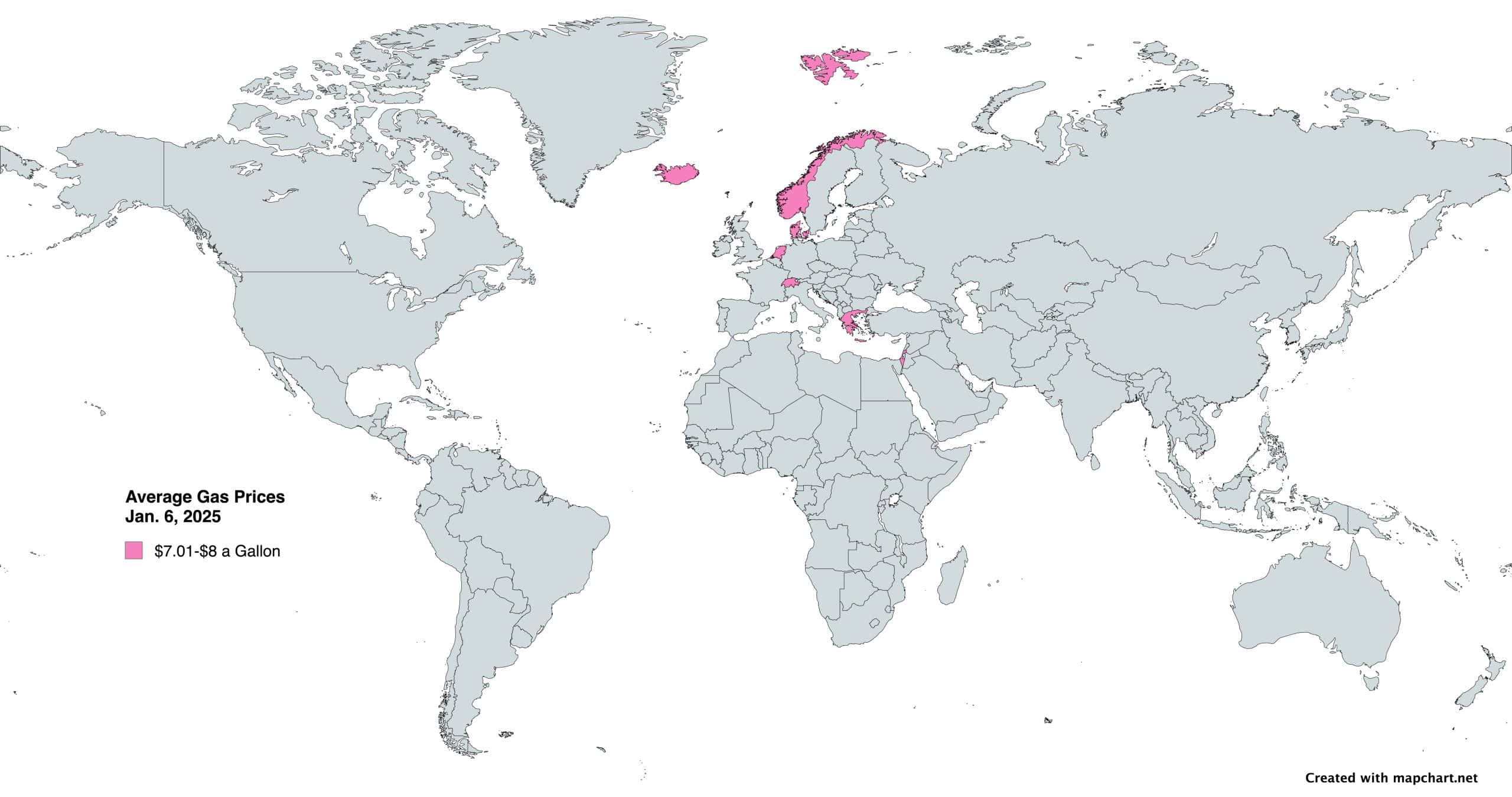
These countries have among the very highest gas prices in the world. Norway is a bit of a surprise on this list as it is a major oil producer from North Sea oil drilling. However, it exports much of what it recovers to other European countries. Norway and Iceland have forbidding climates that increase demand for heating fuel and rugged geography that makes it expensive to transport fuel to remote areas.
- Greece: $7.042
- Norway: $7.203
- Barbados: $7.275
- Switzerland: $7.352
- Liechtenstein: $7.448
- Netherlands: $7.594
- Singapore: $7.686
- Israel: $7.724
- Denmark: $7.849
- Monaco: $8.338
- Iceland: $8.452
Countries Where Gas is Over $9 a Gallon

Hong Kong is not an independent country, but is an autonomous city-state in China. Built mainly on an island, it is one of the most crowded and expensive cities in the world with almost no room to expand. The ridiculously high price of gas there pushes most of the population into mass transit rather than clogging the streets with more cars. Approximately 33% of the price of gas is from a government excise tax on imported fuel. So, driving in Hong Kong is treated more as a luxury than a necessity.
- Hong Kong: $12.748
Take Charge of Your Retirement In Just A Few Minutes (Sponsor)
Retirement planning doesn’t have to feel overwhelming. The key is finding expert guidance—and SmartAsset’s made it easier than ever for you to connect with a vetted financial advisor.
Here’s how it works:
- Answer a Few Simple Questions. Tell us a bit about your goals and preferences—it only takes a few minutes!
- Get Matched with Vetted Advisors Our smart tool matches you with up to three pre-screened, vetted advisors who serve your area and are held to a fiduciary standard to act in your best interests. Click here to begin
- Choose Your Fit Review their profiles, schedule an introductory call (or meet in person), and select the advisor who feel is right for you.
Why wait? Start building the retirement you’ve always dreamed of. Click here to get started today!
Thank you for reading! Have some feedback for us?
Contact the 24/7 Wall St. editorial team.



